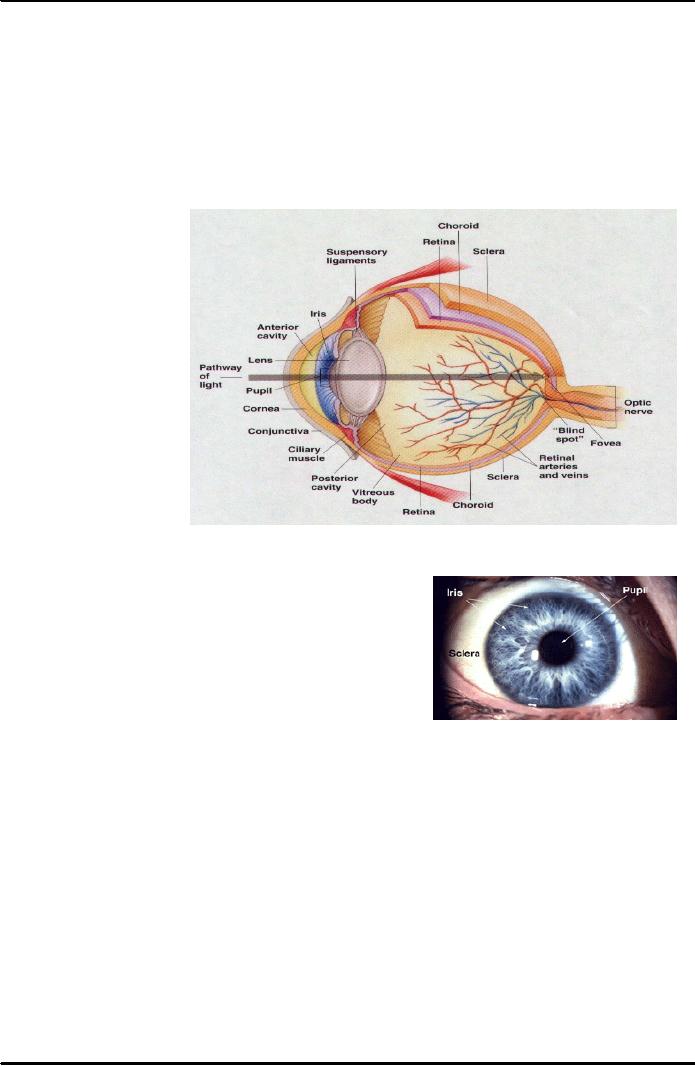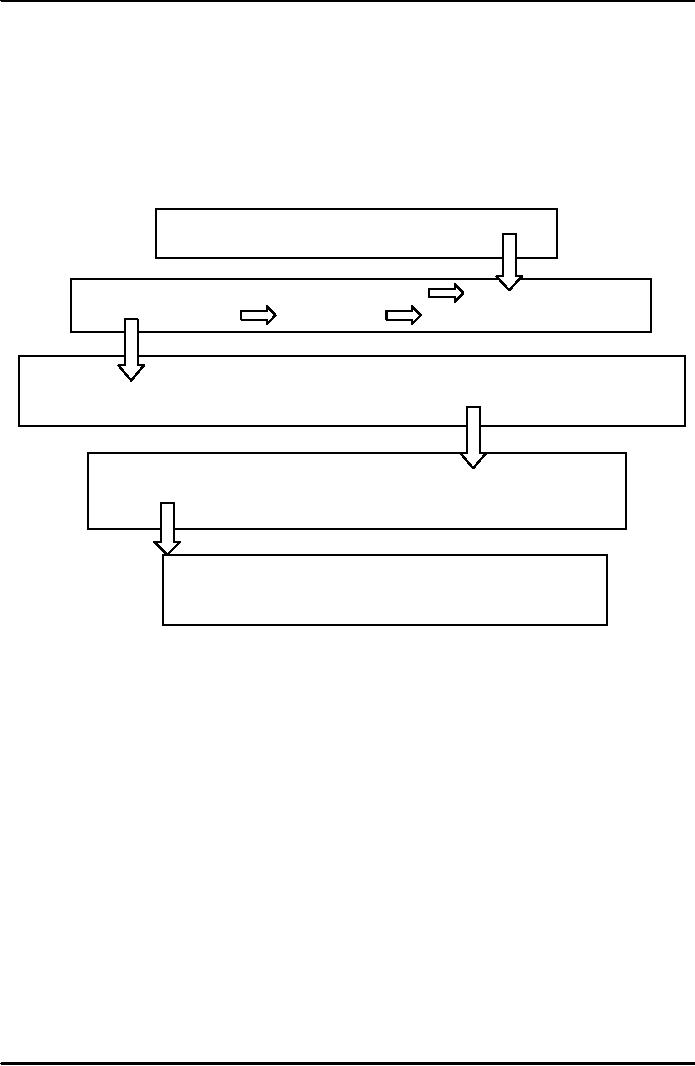 |
SENSATION:The Human Eye, Cornea, Sclera, Pupil, Iris, Lens |
| << ENDOCRINE SYSTEM:Pineal Gland, Pituitary Gland, Dwarfism |
| HEARING (AUDITION) AND BALANCE:The Outer Ear, Auditory Canal >> |

Introduction
to Psychology PSY101
VU
Lesson
15
SENSATION
Traditionally,
the five special senses have
been defined as taste,
smell, sight, hearing and
feeling. However,
touch
is now considered to reflect the activity
of the general senses, and
equilibrium, or balance, can
be
thought
of as a new fifth special
sense. In contrast to the general
sensory receptors, most of
which are
modified
dendrites of sensory neurons, the
special sensory receptors
are distinct receptor cells.
They are
either
localized within complex sensory
organs such as the eyes and
ears, or within epithelial
structures such
as
the taste buds and olfactory
epithelium.
The
principle function of the special
sensory receptors is to detect
environmental stimuli and
transfer their
energy
into electrical impulses.
These are then conveyed
along sensory neurons to the central
nervous
system,
where they are integrated and
processed, and a response is
produced.
There
is no firm agreement amongst
neurologists as to exactly how
many senses there are.
The
disagreements
stems from a lack of
consensus as to what the definition of a
sense should be. Although it
is
still
routinely taught that there
are five senses (sight,
hearing, touch, smell, taste; a
classification first
devised
by
Aristotle, it is generally agreed
that there are at least
nine different senses in
humans, and a minimum
of
two
more observed in other
organisms.
A
broadly acceptable definition of a
sense would be "a
system that consists of a
sensory cell type (or
group
of cell types) that respond
to a specific kind of physical energy,
and that correspond to a
defined
region (or group of regions)
within the brain where
the signals are received
and
interpreted".
Where
disputes arise is with
regard to the exact classification of the
various cell types
and
their
mapping to regions of the brain. It can
also be defined as:
�
Sensation
is a process that makes
possible, and facilitates
our contact with
reality
�
`To
sense' means to become aware
of something
�
All
living organisms have sense
organs. Sensation is the process by
which our sense organs
respond
to
different stimuli
�
It is the
mechanism through which
stimuli from outside or
inside the body are received
and felt by
different
faculties e.g., hearing,
sight, smell, touch, taste,
and equilibrium.
In
the process of sensation the incoming
(afferent) nerve impulse is registered in
that part of the brain,
which
has a potential of such reception.
The awareness of a stimulus
results from the perception of the
sensory
receptors
The
five senses
�Vision
�Hearing/
Auditory sense or Audition;
also associated with
maintenance of bodily
balance
�Smell/
Olfaction
�Taste
�The
skin sensations/ Kinesthetic sense; touch,
pressure, temperature, and
pain
Vision/The
visual Sensation
�The
sensation that takes place
through the function of eyes;
eyes receive the visual
messages or
stimulation,
that is carried by nerves to the
concerned part of the brain
that processes the
received
information.
The
Human Eye
�
The
eye is a very complex, delicate,
and vital structure, that is
responsible for an
organism's
interaction
with the external world. It is the most
important and influential
sense organ.
�
It
receives information from the
outside world in the form of
light, and sends loads of
information
to
the brain all the time
�
The
human eye is a little less
than one inch in diameter
and almost spherical
�
The
eye has a very specific
design or form, which
captures and processes light
coming from
outside...light
reflected by the stimuli
88

Introduction
to Psychology PSY101
VU
�
Eyes
function like a camera, which
has its aperture, and a
lens through which the light
enters and
cells
present in it process the received
light just as do the intricate internal
parts of the camera.
Anatomy/
Structure of the
Eye
The
anatomy of the eye is broadly
divided into three parts
along with its
chambers
i.
The external structure of the
eye
ii.
The immediate structure of the
eye
iii.
The internal structure of the
eye
All
structures are important in
terms of their processing
and functioning
The
External Structure
The
entire external structure of the eye is a
"light-tight" box
Cornea
�
A
transparent
external
surface, a
five-layered
membrane
that
covers
both the
pupil
and the iris.
�
It is the
first and
most
powerful
lens
or layer of the
visual
apparatus
that
helps to form
the
sharp image
on
the retinal
photoreceptor
cells,
along with
the
crystalline lens
Sclera
�
Outer
walls of the eye are formed
by a hard, white
substance
called `sclera', hence
sclerotic coat that
covers
5/6th
of the surface of the eye
�
The
outside of the eye is light-tight
and its mechanism is
designed
in such a manner that only
small amount of
light
can enter into a small
opening that enables
the
production
of a clearer vision, because a
smaller opening
also
acting as the `aperture', creates a
sharper image
The
Immediate Part
Pupil
�
A dark,
adjustable opening in the center of the
eye through which the light
enters. It changes its size
as
the
amount of light entering the eye
varies
�
It looks dark
and black in appearance,
because of the absorbing pigments in the
retina
Iris
�
Around
the pupil of the eye, there is a
ring of muscle tissue that
controls the size of the pupil
opening,
through its contraction and
expansion
�
It
contains the color pigments
and thus gives color to the
eye__ the color which the
eyes possess
such
as brown, black, green, blue
etc are due to the iris
muscles
Lens
�
The
transparent part of the eye
that is located behind the
pupil that changes it shape
in order to
focus
images on the retina
89

Introduction
to Psychology PSY101
VU
�
The
lens changes its own
thickness in order to focus
image properly on retina__ this ability
of the
lens
is called "
accommodation"
�
The
process of accommodation depends
largely on the location of the object
with respect to the
observer's
body __ distant objects require a relatively
flat lens and the muscles
that are controlling
it
are
relaxing as compared to when focusing the
nearer objects, when muscles
contract, taking
tensions
off the lens thus making the
lens more round
shaped
Fluids
in the Chambers of the
Eye
�
Eye
has three important layers
or chambers:
Anterior
layer that lies between
the cornea and iris
i.
ii.
Posterior
layer that lies between iris
and lens
Vitreous
layer that lies between
the lens and the
retina
iii.
�
Anterior
and posterior chambers
are filled with aqueous
humor
�
Whereas
the vitreous
chamber is
filled with a more viscous
fluid, the vitreous humor
�
The
eye is filled with these
two liquids that are
important because they help maintain
the
shape
of the eye and provide nourishment to the
cells present in the
eye
�
The
function of these fluids is the
same as that of blood in
other parts of the body;
the
difference
being that these liquids are
nearly transparent, so that they
can nourish the cells
of
the eye without interfering
with the light that enters
in the eye
Choroid
It
is the middle layer of the eye,
and the lining of the 3/5th of the
eyeball
�
The
choroid serves two important
functions; i.e. nourishment and
absorption
�
The
choroid carries blood to the retina
and the humors in order to
provide nourishment to the eye
�
The
other important function is
that choroid absorbs any
light that strikes on it__
this is extremely
important,
because light that passes
through the rods and cones
does not reflect back. But,
in any
case,
if it (light) reflects back, the
photo-sensitive cells would receive the
light message twice,
and
would
percept wrong, that there
was twice as much light as
there really was.
Internal
Structure of the
Eye
�
Includes the
most important
structure;
"the retina".
�
Retina
is the light- sensitive inner
surface or chamber of the eye
that converts the
electromagnetic
energy
of the light into useful
information for the brain.
�
It
contains about 130 million
nerve cells.
�
It
contains the receptors rods
and cones plus the neurons;
these cells are very
important as they
initiate
the processing of visual
information.
�
The
retina has an area of 5 square
centimeters located at the back of the
eye, which is a
location
where
all light detection takes
place.
�
The
retina is a network of nerve cells
connected with over 100
million photosensitive rod
and
cones.The
signals generated by these
rods and cones are
then sent, via the optic
nerve, to the visual
areas
in the brain
Plexiform
Layer
�
It is the
top layer of the retina, which
does not interpret the light
striking this part
�
A
web of optical nerves that
carry signals of rods and
cones to the optic
nerves
�
It is
located between the photosensitive cells
and the vitreous humor so that the
web's cells can be
nourished
�
These
cells are nearly transparent
so only minimal interference takes
place when light strikes on
the
photosensitive
cells
90

Introduction
to Psychology PSY101
VU
Rods
and Cones
a.
Rods
�
Retinal
receptors which are long,
cylindrical, and light sensitive;
that can only detect
black, white and
gray;
they functions well in dim
light, and are largely
insensitive to color and
small details__
functions
when
cones do not respond
�
Rods
are used for `peripheral
vision', i.e. the objects
that are outside the main
center of focus, and
for
night
vision
b.
Cones
�
Retinal
receptors, cone- shaped and
light sensitive, concentrated
near the center of the retina that
is
concerned
with sharp focusing, fine
details and color sensation;
they work well in well- lit
conditions
i.e.,
bright or sufficient
light
�
Rods
and cones are distributed
unevenly throughout the retina
�
There
are fewer cones i.e. about
seven million than rods
i.e., 125 million
Important
Regions of Retina; Fovea and Blind
Spot
a.
Fovea
�
The
very sensitive and important
part of the retina that aids in
focusing; it is the area of best
vision.
�
The
largest concentration of cones is present
in fovea
�
There
are no rods present in
fovea
b.
Blind Spot
�
The
area/ point where the optic
nerve leaves the eye; no receptor
cells are located
here,
thus creating a " blind" spot__
area of no vision
The
Human Eye
Rods
Cones
Transfer
of Visual
Information
from the Eye to
125-Million
6-7Million
the
Brain
Number
�
As the
light strikes the
receptor
cells i.e. rods
Periphery
Location
in the
Center
and
cones, the chain of
events
begin, which
transforms
the light
Sensitivity
in dim
Low
High
impulses
into the neural
impulses,
which are
then
sent to the brain
Color
sensitive
Yes
No
via
the optic nerve
�
Before
reaching the
brain,
some initial transformation in the
visual information takes
place
�
Rods
contain "RHODOPSIN"__ a
reddish- purple substance, in
which chemical
reaction/
changes
occur when activated by
light
�
Substance
in the cones is different from
that of rods__ but their principles of
functioning are
similar
�
Functioning
of the neural impulses begins
when stimulation of nerve
cells in the eye takes
place__
information
is transmitted to the brain by "
bipolar cells" and
"
ganglion
cells"Bipolar
cells
are
the nerve cells leading to the
brain__ triggered by the nerve
cells in the eye; they
receive
information
directly from rods and
cones and then that
information is transferred to the
ganglion
cells
�
Ganglion
cells are
the nerve cells that collect
and summarize visual
information from rods
and
cones
and then transfer it to the brain; the
visual information is moved out
from the eyeball
through
the optic nerves
91

Introduction
to Psychology PSY101
VU
�
Optic
nerve contains
bundled ganglion axons; located at the
back of the eye, optic nerve
carries
information
to the brain
�
When
optic nerve leaves the
eyeball, it does not take
the direct route to the brain, instead, the
optic
nerves
of both eyes meet, or
intersect, at a point called
"optic chiasm"__ point where the
optic
nerves
are reversed and ` righted'
in the brain
�
When
the optic nerves split at this
point, the nerve impulses
from the right half of each
retina go to
the
right side of the brain and
those from the left half to
the left side of the
brain
Processing
of Visual Information
�
When
information reaches the brain, it passes
through a number of stages
�
At
first, the ganglion cells are
activated (summarize information
from rods and
cones)
�
In
some cases, ganglion cells
are activated by light in the
middle/ center, whereas,
some ganglion cells
are
activated
when there is darkness in the center
and light in the surrounding areas; the
ultimate function is
to
maximize the detection of variations in light
and darkness
�
The
entire processing of visual information
takes place in the visual cortex of the
brain which is quite
complex
Feature
detection occurs
when the neurons in the visual cortex are
activated on seeing the particular
shape/
pattern; discovered by the Nobel- prize
winners David Hubel and
Torsten Wiesel
�
They
found out that some
cells are activated only on
particular shape/ pattern, while only
moving
stimuli
activates other cells
Adaptation
�
The
process of the eye becoming
used to a certain amount of light is
called adaptation
�
What
will happen when you enter
into the movie theatre/ a dark
room and hardly see
anything?
The
isle, other people, or your
seat. And what happens after a few
moments? It is an example of
adaptation
to darkness
�
Dark
Adaptation means a heightened sensitivity
to light resulting from being in low
level of light
for
some duration
�
On the
contrary, you can see quite
well in light after coming from the
darkness__ dark adaptation
�
The
speed of processing from dark to
light and light to dark adaptation is
largely dependent on the
rate
at which the chemical composition in the
rods and cones takes
place
Color
Vision: Color, Effects and
Uses
Color
�
In
reality, in the physical world,
there exist no colors __
only light waves of
different wavelengths
are
what
we perceive as colors
�
When
our eyes look at an object, we
actually see the reflection of light
after striking some object
�
The
normal human eye has the
ability to differentiate/ distinguish
among hundreds of such bands
of
wavelengths
as they are received by the cones
(sensory cells) of the retina___ this
ability makes it
possible
to perceive the world in
color
�
Human
eye has the ability to distinguish
among hundreds of wavelengths
but our ability is quite
limited,
and
the way we describe it is even
more restricted
�
A
color name refers to
attributing the colors of what we
perceive in prototype of the range of
different
wavelengths
e.g. "red" refers to colors
that have more red
attributes than orange/ yellow
attributes, and
the
word "orange" refers to
colors that have more
orange attributes, so as the "yellow" as
there really is
no
clear-cut distinction
Perception
of Color
�
Depends
on subjective experience
�
The
wavelengths referred to by two people
using the same color name
almost always differ
�
Also,
due to the biological basis of
our color vision, there is a
high degree of universality in the
use
of
color terms across cultures
and languages
92

Introduction
to Psychology PSY101
VU
Is
There Any Psychological Effects of
Color
�
Do
colors have any effect/
impact on our emotions and
behavior? ___ the answer is
yes. But what
kind
of effect and how it affects
our emotions and behavior is
not yet conclusive
�
Our
reactions to colors are
affected by a combination of biological,
physiological, psychological,
social
and cultural factors
�
Certain
colors seem to be more
universal in their effects on
mood and behavior___ they
are known
as
"warm" and "cool"
colors
Warm
colors: include
magenta, red, orange,
yellow, and yellow-green mainly; these
speed up our
perception
of time and produce feelings
that are warm, cozy,
and inviting.
These
colors are the associated
with excitement, happiness
and comfort
Cool
Colors: include
violet, blue, light blue, and sea
green generally
Emotions
associated with these colors
range from soothing, calmness,
and peacefulness to
sadness,
withdrawal
and repression
Different
cultures and societies use
specific colors for particular
occasions, which symbolize
their culture
and
tradition. e.g. White
color
The
Use of Color and in professional and
everyday life
Color
is one of the most effective tools
in
�
Fashion
�
Advertising
�
Presentations
etc
Psychologists
believed that color impression could
account for 60% or more of the
acceptance or rejection
of
that product or
service
Color
Vision
�
Not
only a exciting and pleasurable
experience but it also helps
in locating and identifying objects in
the
visual
scene that would be hard to be
identified if only in shades of
gray
�
The
ability to detect, differentiate
and discern different colors
(wavelengths) gives us more
information
for
detecting and identifying
objects than would be
provided solely by black and
white vision
�
Color
vision is mediated by specialized
nerve cells in the retina known as
"cones" that function only
in
bright
light
�
When
light becomes dim, rods
take over, and they provide
neither color vision nor
high acuity (ability
to
detect fine detail, such as
that needed for
reading)
Color
Vision Needs Several Different
Pigments
�
During
the 1800's, visual pigments
were discovered in the retina
�
Both
rods and cones possesses
visual pigments
�
This
pigment molecule (embedded in the cell
membrane of the photoreceptor), is a large
protein
called
an `opsin',
and is
coupled with a small molecule
called a `chromophore'
(a
form of Vitamin
A)
that absorbs light
�
When
the chromophore absorbs light, it changes
its shape which, in turns,
activates the large opsin
molecule___
leads to a molecular event
that culminates in an electrical
change in the cell
membrane
�
The
electrical signal is, then
send to the retinal ganglion cells,
whose axons take the
information
about
light (electrical signals) to the
brain
�
Researches
have shown that mainly three
pigments (photoreceptor cells)
with different
combinations
could produce vision that is
capable of detecting all
colors of the visible spectrum
�
Scientists
found that the human retina
has three types of cones,
each containing a different
visual
pigment.
They are red,
green, and blue cones, each
containing a pigment similar to
rhodopsin
(pigment
found in rods)Cone cells
detect primary colors, but
our brain mixes these
colors in
seemingly
infinite variable proportions due to
which we are able to
perceive a wide range of
colors
�
Red
cones absorb `longer
wavelengths', green cones
`medium wavelengths', and blue
cones `shorter
wavelengths'
93

Introduction
to Psychology PSY101
VU
Theories
of Color Vision
�
A
realistic and useful
understanding about the structure and the
function of the eye began
in
around
17th century when the gross anatomy of the
eye was firmly
established
�
The
two most prominent German
and French researchers
Johannes Kepler and Rene'
Descartes
made
many discoveries/ advances in understanding
vision
�
Most
of their work concentrated on the
physical concepts of light
rays and geometric optics in
the
visual
process
�
Kepler
was the first to propose
that the lens of the eye
focuses images onto the retina
Kepler's
investigations
were found correct when,
after few decades, Descartes did
experiments on this
�
He postulated
that the image was inverted
as a result of being focused onto the
retina by the eye's
lens
�
In
his landmark experiment, Descartes
surgically removed an eye from an ox
and scraped the back
of
the eye to make it transparent. He
then placed the eye on a
window ledge as if the ox
were
looking
out of the window. He looked at the
back of the eye and saw an
inverted image of the
scenery
outside__ he, then, correctly postulated that the
image was inverted as a
result of being
focused
onto the retina by the eye's
lens
Goethe's
Theory of Color
�
Writer
and scientist
�
Wrote
1400-page treatise on color __ published
in 1810
�
Goethe
believed that the color sensations
that reach our brain
were shaped by our perception --
by
the
mechanism of human vision
and by the ways our brain
processes information
�
Therefore
what we see of an object largely depends
on the object, the lighting and
our
perceptionStudied
after-images, colored shadows and
complementary colorsSought to derive
laws
about
�
Color
harmony,
�
Methods/
ways of characterizing physiological
colors (how colors affect
us) and
�
Subjective
visual phenomena
Thomas
Young
�
Thomas
Young introduced the original
theory of color vision around
1790, prior to the
discovery
of
the cone cells in the retina
�
Young
was the first to propose
that the human eye sees
only the three primary colors,
red, blue and
yellow
and that all of the other
visible colors are combinations of
these
�
It is
now known that color
vision is more complicated
than this, but Young's
work formed the
foundation
of color vision theory for
the later scientists
Three
Main Theories of Color
Vision
�
There
are a number of theories related to
color vision and color
blindness, but the three
very
important
and famous theories
are;
1.
Parallel processing theory of
vision
2.
Trichromatic theory of color
vision
3.
Opponent- process theory of color
vision
I.
Parallel Processing Theory of
Vision
�
The
brain's distinctive and natural way of
processing information in which
various aspects
of
information are processed
simultaneously__ includes many
brain functions such
as
vision;
contrasts with the serial/
step- by- step processing of
most computers and of
conscious
problem solving
�
Unlike
most computers, which work/
processes information instantly through
step- by-
step
serial processing, humans do parallel
processing___ means do several things at
one
time
94

Introduction
to Psychology PSY101
VU
�
Our
brain is capable of dividing
visual information into
various dimensions/
categories
such
as color, depth, movement etc and
works on each aspect/ part
simultaneously
�
Visual
information is processed in the following
manner. i.e.
One
looks at someone/ something
o
Information
is sent to the brain
o
The
component features are reassembled
and,
o
In,
still not a clearly and
exactly known way, the scene
is combined/ composed into
the
o
consciously
perceived meaningful image
Parallel
Processing Theory of Vision
Environmental
Stimuli
= scene
Retinal
processing: receptors
rods
and
bipolar
cells
ganglion
cells
cones
Feature
detection
Brain's
detector cells responds to
elementary features__ bars,
edges or
gradient
of light
Abstraction
Brain's
high-level cells respond to
combined
Information
from feature detector
cells
Recognition
Brain
matches the constructed
image with
stored
images
Trichromatic
Theory
�Initially
by Sir Thomas Young, and
later developed as Young-Helmholtz Trichromatic
Theory of Color
vision
�The
retina contains three types of
cones. Each type responds to
specific range of wave
length
Hering's
Opponent- Process Theory
�The
receptor cells are linked in
pairs and they work in
opposition to each other
�There
is a black- white pairing, a blue- yellow pairing,
and a red- green pairing
�
If
an object reflects light containing
more green than red, it
will stimulates the firing of the
cells sensitive
to
green, at the same time inhibiting the
firing of red- sensitive cells; the
object will thus appear
green
�This
theory explains the phenomenon of after-
image very well
Color
Vision Deficiencies: Congenital And
Acquired
�
Color
vision deficiencies are
classified into congenital and
acquired
�
Congenital
deficiencies are due to the
inborn abnormality of cone
photoreceptor cells
�
Acquired
deficiencies results any time after
birth___ occur due to the
disorders that affect the
eye
or/
and the brain
�
In
both of these deficiencies, people
experience colors differently
from those with
normal
trichromatic
color vision
95

Introduction
to Psychology PSY101
VU
�
Three
main congenital color deficiencies
are;
I.Dichromacy
II.Anomalous
trichromacy
III.Rod
monochromacy
I.
Dichromacy
�
Individuals
with this deficiency are
able to match all the colors
using two primaries
rather
than
three
�
Dichromatic
miss one of the three cone
types
There
are the following three main
types of dichromacy, which
are named on the basis of
cone photo
pigment
that is missing. They
are;
1.
Protanopia
2.
Deuteranopia
3.
Tritanopia
�
Both
protanopia and deuteranopia
are sex-linked i.e. inherited
recessively from a gene
located on the X
chromosome
�
If
this deficiency is inherited, males
(XY) will manifest it
because they have only one
X
chromosome__females
(XX) have two X chromosomes,
so they will only be color
deficient if the
deficiency
is carried on to both X chromosomes. They
can pass this condition to
their male offspring
without
being color deficient themselves
ProtanopiaRed
photo pigment is absent and is
replaced by the
medium
green photo pigment due to this; people
with this deficiency confuse
red and green
color
�
See
shorter wavelengths such as blue
DeuteranopiaAlso
confuse red and
green
It
is sex- linked deficiency
and effect about 1% of males
and .01% of females
Tritanopia
Basis
of this deficiency is not yet
clear__ may occur due to the
absence of short wavelengths such as
blue
People
with this deficiency are
insensitive to blues and
yellows and see the world in
red and green
A
very rare condition and
occur only in .002% of males
and .001% of females
Anomalous
trichromacy
�
People
with this deficiency mix the
primaries in different
proportions
�
Like
normal trichromats, these people also
need three wave lengths___
but due to spectral
sensitivities,
they
often mingled them up
Rod
monochromacy
�
Extremely
rare hereditary condition which
occurs due to the absence of
cones in the eye
�
As
vision is dependent on the rods
photoreceptors, the acuity is very weak
because of the absence of
cones
�
Absence
of cones are also
responsible for poor
fixation, erratic eye
movements, visual fields defects
and
serious
refractive error
Color
Blindness
�Inability
to see specific colors
�25
of men and 2 out of 10,000
women are color
blind
�Red-
green color blindness;
inability to distinguish red from
green
�Yellow-blue;
the person can not
differentiate between yellow
and blue
�Monochromatic
color blindness; inability to
perceive any color at
all
�The
Trichromatic theory explains this
phenomenon very well
96

Introduction
to Psychology PSY101
VU
Every
Day Experiences and Color
Vision Deficiencies
�
Our
daily routine is highly dependent on the
efficient ability to discriminate
among colors such as
selecting
clothes, matching paint
colors etc, that requires
efficient color vision___
inability/ deficiency
can
seriously
effect individual's ability to learn, to
work or to move freely from one
place to another
�
Colors
play an influential role in child's
initial/ primary education because it is
used to categorize the
educational
materials
�
Good
color judgment is also important as
far as the occupation of the person is
concerned__ essential
for
the
painter, pilots, surgeons,
military men, safety
officer, dermatologists, pharmacists,
chemist, buyer of
textiles,
food inspectors, electricians
and marine navigator
�
Extensively
used for communicating safety
information__ color coded
targets are easily noticed
and
quickly
detected
Red
stands out for fire,
danger, or stop
Yellow
for amber
Blue
indicates need for
caution
Green
to signal safety
Orange
to communicate potential danger
and
Purple
to warn about for radiation
hazards
97
Table of Contents:
- WHAT IS PSYCHOLOGY?:Theoretical perspectives of psychology
- HISTORICAL ROOTS OF MODERN PSYCHOLOGY:HIPPOCRATES, PLATO
- SCHOOLS OF THOUGHT:Biological Approach, Psychodynamic Approach
- PERSPECTIVE/MODEL/APPROACH:Narcosis, Chemotherapy
- THE PSYCHODYNAMIC APPROACH/ MODEL:Psychic Determinism, Preconscious
- BEHAVIORAL APPROACH:Behaviorist Analysis, Basic Terminology, Basic Terminology
- THE HUMANISTIC APPROACH AND THE COGNITIVE APPROACH:Rogers’ Approach
- RESEARCH METHODS IN PSYCHOLOGY (I):Scientific Nature of Psychology
- RESEARCH METHODS IN PSYCHOLOGY (II):Experimental Research
- PHYSICAL DEVELOPMENT AND NATURE NURTURE ISSUE:Nature versus Nurture
- COGNITIVE DEVELOPMENT:Socio- Cultural Factor, The Individual and the Group
- NERVOUS SYSTEM (1):Biological Bases of Behavior, Terminal Buttons
- NERVOUS SYSTEM (2):Membranes of the Brain, Association Areas, Spinal Cord
- ENDOCRINE SYSTEM:Pineal Gland, Pituitary Gland, Dwarfism
- SENSATION:The Human Eye, Cornea, Sclera, Pupil, Iris, Lens
- HEARING (AUDITION) AND BALANCE:The Outer Ear, Auditory Canal
- PERCEPTION I:Max Wertheimer, Figure and Ground, Law of Closure
- PERCEPTION II:Depth Perception, Relative Height, Linear Perspective
- ALTERED STATES OF CONSCIOUSNESS:Electroencephalogram, Hypnosis
- LEARNING:Motor Learning, Problem Solving, Basic Terminology, Conditioning
- OPERANT CONDITIONING:Negative Rein forcer, Punishment, No reinforcement
- COGNITIVE APPROACH:Approach to Learning, Observational Learning
- MEMORY I:Functions of Memory, Encoding and Recoding, Retrieval
- MEMORY II:Long-Term Memory, Declarative Memory, Procedural Memory
- MEMORY III:Memory Disorders/Dysfunctions, Amnesia, Dementia
- SECONDARY/ LEARNT/ PSYCHOLOGICAL MOTIVES:Curiosity, Need for affiliation
- EMOTIONS I:Defining Emotions, Behavioral component, Cognitive component
- EMOTIONS II:Respiratory Changes, Pupillometrics, Glandular Responses
- COGNITION AND THINKING:Cognitive Psychology, Mental Images, Concepts
- THINKING, REASONING, PROBLEM- SOLVING AND CREATIVITY:Mental shortcuts
- PERSONALITY I:Definition of Personality, Theories of Personality
- PERSONALITY II:Surface traits, Source Traits, For learning theorists, Albert Bandura
- PERSONALITY III:Assessment of Personality, Interview, Behavioral Assessment
- INTELLIGENCE:The History of Measurement of Intelligence, Later Revisions
- PSYCHOPATHOLOGY:Plato, Aristotle, Asclepiades, In The Middle Ages
- ABNORMAL BEHAVIOR I:Medical Perspective, Psychodynamic Perspective
- ABNORMAL BEHAVIOR II:Hypochondriasis, Conversion Disorders, Causes include
- PSYCHOTHERAPY I:Psychotherapeutic Orientations, Clinical Psychologists
- PSYCHOTHERAPY II:Behavior Modification, Shaping, Humanistic Therapies
- POPULAR AREAS OF PSYCHOLOGY:ABC MODEL, Factors affecting attitude change
- HEALTH PSYCHOLOGY:Understanding Health, Observational Learning
- INDUSTRIAL/ORGANIZATIONAL PSYCHOLOGY:‘Hard’ Criteria and ‘Soft’ Criteria
- CONSUMER PSYCHOLOGY:Focus of Interest, Consumer Psychologist
- SPORT PSYCHOLOGY:Some Research Findings, Arousal level
- FORENSIC PSYCHOLOGY:Origin and History of Forensic Psychology